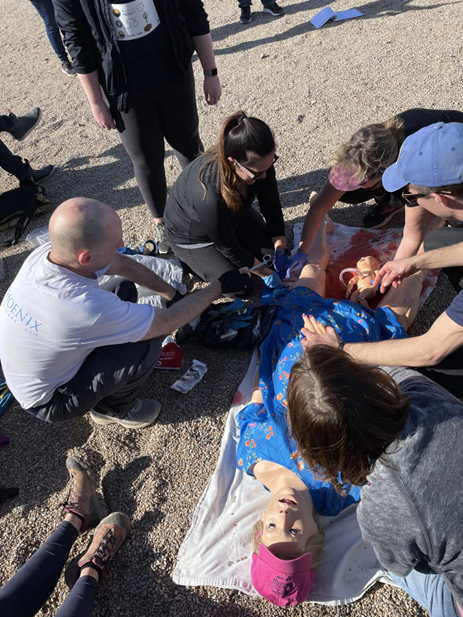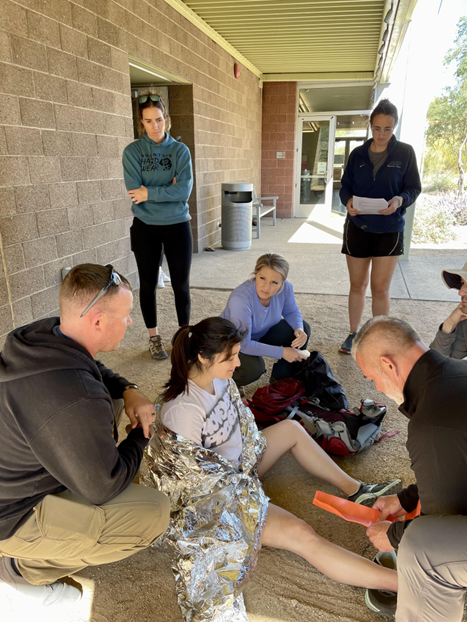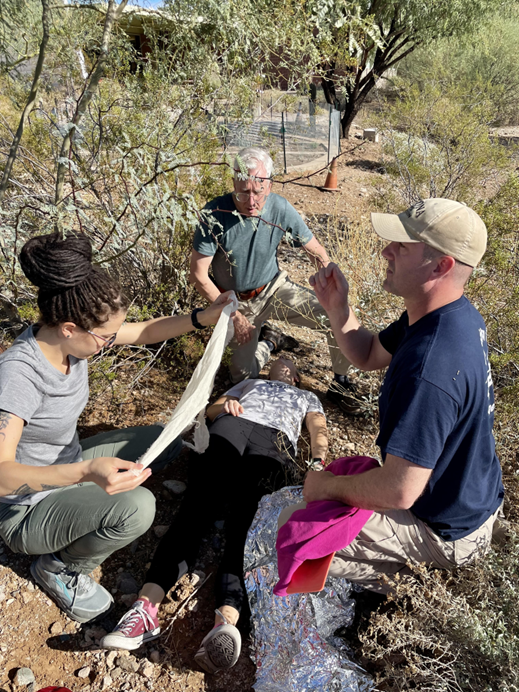Geoff Comp, DO, FACEP, FAWM
Cody Blentlinger, DO
Walker Plash, MD, FAWM
Stephanie Lareau, MD, FACEP, FAWM, DiMM, DiDMM
Justin Gardner, DO, FAWM, DiMM, DiDMM, FACEP
Marc Cassone, DO, FAWM, DiMM
This is the first of a series of articles by the WMS Student/Resident Education Committee on designing and running wilderness medicine training simulations for learners.
Training scenarios are a cornerstone of wilderness medicine teaching, providing a safe and controlled environment for learners to practice and hone their skills. However, creating realistic, engaging, and educational scenarios for wilderness medicine can be challenging and requires careful planning and creativity. From simulating environmental hazards to creating convincing injury and illness scenarios, these simulations can transform theoretical knowledge into practical skills. This idea bridges the gap between classroom knowledge and real-world application and helps to make learners more prepared for real-life emergencies. Whether you are an EMT, outdoor enthusiast, expedition guide, or wilderness medicine physician, these tips will help you design scenarios that challenge and inspire your learners.
Tips for Creating Effective Scenarios
1. Define Clear Learning Objectives
Start by defining your learning objectives. Determining what specific skills or knowledge you want your learners to acquire or demonstrate will guide your scenario's development and ensure it meets educational goals. Using a template, such as SMART objectives, can be helpful in objective creation. Make sure to communicate these objectives to the other proctors.
2. Promote an Open Learning Environment
Before the scenario, ensure participants understand that the primary goal is learning and practice, not always performance. Complex and prolonged scenarios can lead to stressful situations; encourage constructive dialogues and full participation. Learners can often surprise you with their innovative solutions. Be flexible in these moments and be ready to provide feedback regarding unexpected approaches.
3. Tailor Scenarios to Learner Levels
Ensure your scenarios are appropriate for the learners’ skill levels and abilities. Learning objectives and skills reinforcement for a WFA course should differ from those intended for experienced wilderness medicine physicians on a CME course. Adjust the complexity and detail of each scenario to match the participants’ experience and knowledge.
4. Prepare the Actors
Create thorough prompts for “patients” so they can adequately portray the aspects of the case. If the “patient'” needs the proctor to answer specific medical questions, it takes away from the realism of the case. Have the participants obtain vital signs or listen to lung sounds rather than just requesting this information from the proctor. Sometimes, using prompts taped to various parts of the “patient’s” body can eliminate excessive interaction with the proctor. For example, a notecard could be taped to the abdomen, indicating rigidity and guarding on abdominal examination.
5. Conduct Thorough Debriefs
Scenario debriefing is crucial. A supportive, organized, and respectful debrief environment helps learners reflect on their performance and solidify their learning. Decide ahead if you will do a “mega debrief” at the end and/or “timeouts” during the scenario: these correct faulty actions early and in real-time but can interrupt the flow and realism of a scenario. Consider taking notes during more extended scenarios to ensure essential points are not missed and using a debrief schema to frame the discussion. Encourage input from team leads and participants to discuss what went well and what could be improved. Use this time to highlight key learning points and provide constructive feedback. The debrief should also be used to garner participants’ suggested improvements for future iterations of the scenario. The easiest time to update a simulation based on this feedback is immediately after the case when it is fresh in your mind. This approach will help hone your case to your objectives and allow it to run more smoothly.
Common Pitfalls to Avoid
1. Overloading Scenarios
It is easy to get overly ambitious and include too many elements in a single scenario, especially for smaller groups. Avoid adding issues just to complicate a case, as these can often overwhelm or distract learners from core teaching points. Stick to clear, specific objectives. For example, if the goal is to manage a chest wound, save other complications like snake bites for another scenario and ensure the medical aspects of the scenario match the environmental situations.
2. Lack of Realism
A scenario lacking in realism can disengage learners. Make an effort to simulate realistic conditions and physical exam findings. Use appropriate props, gear, and moulage to create a convincing environment. Realism enhances the educational value of the scenario and keeps learners engaged. Simulating a realistic altitude illness or hypothermia case can be challenging if the session is hosted in the summer in southern Florida. However, all efforts should be made to write a realistic case with thoroughly described prompts, including time of day, weather, terrain, location, distance from additional help, and resources available. Devise realistic physical exam findings (makeup for a rash/hives, realistic moulage for injuries and burns) as well as gear appropriate for the case (fins, mask, snorkel, for a dive medicine case; climbing harness, helmet, and gloves for a climbing injury case, etc.). A lack of realism can lead to a disinterested team.
3. Mismatched Scenario Difficulty
Writing overly advanced or simplistic scenarios for participants can lead to frustration and disengagement. Ensure that the complexity of your scenarios matches the learners’ level and number of participants. Adjusting scenarios or creating multiple versions for different skill levels can be beneficial. For example, a provider-level participant may be prepared to manage a traumatic airway or team leadership scenario. In contrast, a W-EMT may need to focus on OPA/NPA placement technique and consider treating environmental concerns, such as hypothermia.
4. Not Setting Parameters Ahead
Ensure participants, proctors, and “patients” understand a scenario's time, geographic, and safety parameters before starting the simulation. Encourage teams to determine leadership roles before the start and encourage participation from all members. It is better to explain more at the outset than to pause or reset the scenario later.
5. Not Planning for Alternate Outcomes
To promote realism and critical thinking, plan different outcomes for each action taken or not taken. If the sucking chest wound on the patient’s back is not identified and addressed promptly, what will be the subsequent results? (Worsening tachypnea, respiratory distress, cardiac arrest, etc.) What will happen if hypothermia is not recognized or a piece of equipment fails or is missing? Ensure proctors and “patients” are aware and responsive to these possible outcomes.
Conclusion
Writing effective and engaging medical scenarios for wilderness medicine training requires a blend of creativity, realism, and thoughtful planning. By defining clear objectives, embracing spontaneity, conducting thorough debriefs, and tailoring scenarios to appropriate skill levels, you can create valuable learning experiences for your participants. Avoid common pitfalls such as overloading scenarios and ensuring realism to keep learners engaged and focused. With these strategies, you’ll help prepare wilderness medicine practitioners for the challenges they may face in the field.

Think outside the box! Using simulation devices outdoors can be incredibly effective by helping to increase the perceived realism as well as provide specific opportunities for skills practice. Here, learners perform a precipitous vaginal delivery on a patient simulator on a desert trail in Phoenix, AZ. (Source: Geoffrey Comp, DO)

Direct observation with well-developed teaching points is critical! Here two proctors watch splint application and provide direct feedback on critical aspects of the procedure. (Source: Geoffrey Comp, DO)

Students actively practice recently learned information and practice specific skills intentionally selected for the scenario. (Source: Geoffrey Comp, DO)